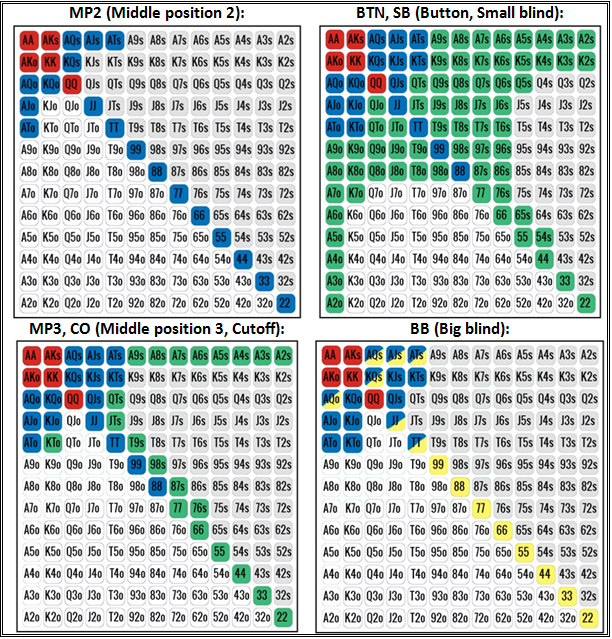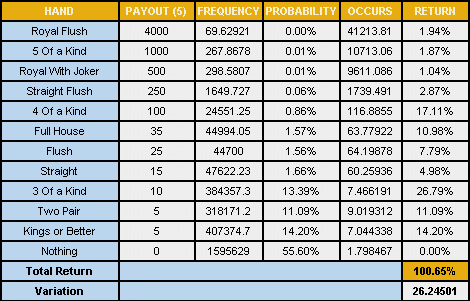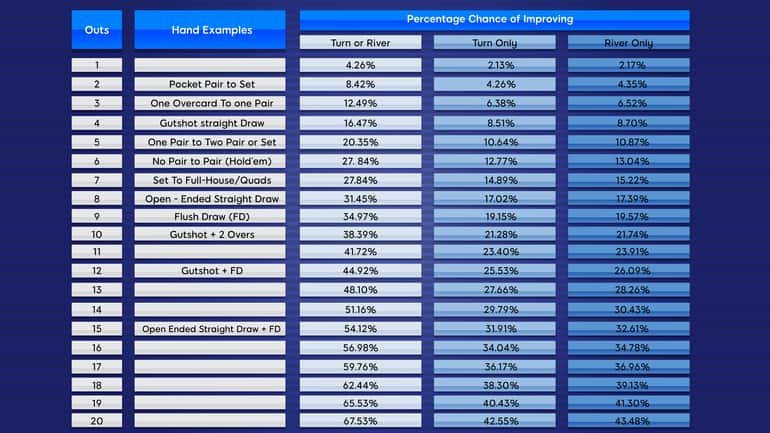Poker Hand Percentages Chart
Odds Charts:Ratio Chart : Percentage Chart : Conversion Chart
Poker Hand Rankings & Charts: Evaluate Your Poker Cards. Before you take us up on our free poker money offer on your way to becoming a World Series of Poker champion, you must first master the basics. The most important in the game is to understand the poker hand strength and rankings. A poker hand range calculator is a great tool to help make smarter decisions when playing for real money. Get in-depth knowledge of calculating hand ranges, equity, and combinations to improve poker. Texas Holdem Heads-Up Preflop Odds. This table was created by enumerating through every possible board and opponent hole card combination for each of the 169 texas holdem preflop starting hands. Poker Odds Charts. Poker odds charts come in useful when you want to quickly work out the odds of winning a hand in Texas Hold'em. The most commonly used odds charts are the 'standard poker odds charts' below, which give both the percentage and ratio odds of completing your draw depending on the number of outs you have (see pot odds and drawing hands for more information). They are a more detailed version of the starting hands section in the cheat sheet above which supplement it nicely. Amazingly they have been downloaded almost 200,000 times! How To Use This Texas Holdem Poker Cheat Sheet. Step 1: Find your hand on the chart (example KT suited) Step 2: Determine whether you should follow coloured or number.
This percentage poker odds chart highlights the percentage chance of completing your draw based on the number of outs you have at different points in a hand. The odds of completing your draw have been rounded to 1 decimal place in this percentage chart.
Look below the table for more information on how to use the percentage odds chart.
Percentage odds chart.
| Outs | 1 Card To Come (flop) | 1 Card To Come (turn) | 2 Cards To Come (flop) |
|---|---|---|---|
| 1 | 2.1% | 2.2% | 4.3% |
| 2 | 4.3% | 4.3% | 8.4% |
| 3 | 6.4% | 6.5% | 12.5% |
| 4 (gutshot) | 8.5% | 8.7% | 16.5% |
| 5 | 10.6% | 10.9% | 20.4% |
| 6 | 12.8% | 13.0% | 24.1% |
| 7 | 14.9% | 15.2% | 27.8% |
| 8 (straight) | 17.0% | 17.4% | 31.5% |
| 9 (flush) | 19.1% | 19.6% | 35.0% |
| 10 | 21.3% | 21.7% | 38.4% |
| 11 | 23.4% | 23.9% | 41.7% |
| 12 | 25.5% | 26.1% | 45.0% |
| 13 | 27.7% | 28.3% | 48.1% |
| 14 | 29.8% | 30.4% | 51.2% |
| 15 (s + f) | 31.9% | 32.6% | 54.1% |
| 16 | 34.0% | 34.8% | 57.0% |
| 17 | 36.2% | 37.0% | 59.8% |
| 18 | 38.3% | 39.1% | 62.4% |
| 19 | 40.4% | 41.3% | 65.0% |
| 20 | 42.6% | 43.5% | 67.5% |
| 21 | 44.7% | 45.7% | 69.9% |
| 22 | 46.8% | 47.8% | 72.2% |
Percentage table key.
- Gutshot - A straight draw with only one card able to complete it. e.g. 6-8 on a 5-9-Q board (only a 7 completes).
- Straight - A standard open-ended straight draw with more outs. e.g. 6-8 on a 5-7-Q board (4 and 9 complete).
- Flush - A hand where another card of the same suit is needed to complete the draw.
- s + f - Both an open ended straight draw and flush combined. e.g. 6 8 on a 5 7 Q board.
How to use the percentage odds chart.
- Work out the number of outs you have (use the colours to help guide you).
- Look up the percentage odds of completing your draw depending on whether you are on the flop or turn.
That's simple enough, but why are there 2 columns for percentage odds on the flop? The first 2 columns with 1 card to come are the odds that you should be using most frequently. These are the standard odds that assume we could potentially face another bet on the next betting round.
The last 2 cards to come column is for when you or your opponent are being placed all in on the flop. Therefore, because you do not expect to have to call another bet or raise on future betting rounds, you can now use these improved odds for seeing 2 cards instead of 1.
If you can't remember or figure out the percentage odds of completing your draw in the middle of hand, try using the rule of 4 and 2 as a rough guide. It's a great little shortcut for percentage odds.
How to turn a percentage in to a ratio.

Divide 100 by the percentage. Then take 1 away from that number and you will have x to 1.

So for example, if you have a flush draw on the turn, the percentage chance of completing your draw is 19.6% (let's call it 20%).

- 100 / 20 = 5.
- 5 - 1 = 4.
- So the ratio is 4 to 1.
It is a good idea to round the percentages to a number that you can easily divide in to 100 to help keep the working out as simple as possible.
Quick percentage odds chart example.

If you have 12 outs to make the winning hand on the flop, you should only call a bet that is equal to 25.5% of the total pot, which is roughly 25%.
So for example, lets say that our opponent has bet $50 in to a $100 pot making it $150. Because we are using the percentage method, we have to add our own potential call of $50 to create a total pot size of $200 - don't forget this! Therefore, based on this final pot size of $200 we can call up to 25% of this amount, which turns out to be $50 anyway. It's a bit tricky, but just as long as you add your own potential call to create the final pot size you will be fine.
For more information on working out percentage odds with drawing hands, see the pot odds article.
Go back to the poker odds charts.
Can You Afford Not To Use
Poker Tracker 4?
“I wouldn’t play another session of online poker without it”
“I play $25NL, and in under 1 week PT4 had paid for itself”
Comments
Poker odds charts come in useful when you want to quickly work out the odds of winning a hand in Texas Hold'em. The most commonly used odds charts are the 'standard poker odds charts' below, which give both the percentage and ratio odds of completing your draw depending on the number of outs you have (see pot odds and drawing hands for more information).
The second set of odds charts highlight interesting odds for different situations in Texas Hold'em. These will help you get to grips with the different likelihood's and chances within the game of poker.
Standard poker odds charts.
Other poker odds charts.
Why use these odds charts?
There are currently many odds charts on the Internet at numerous poker websites. However many of these can be tricky to use. ThePokerBank provides easy to use charts highlighting the key draws on each, which makes them simple and effective to use during play.
I am confident that these odds charts are the easiest charts that you will ever use.
How to use poker odds charts.
Poker odds charts help you to determine how much you can call when trying to complete a drawing hand, such as a flush or a straight draw. By comparing your pot odds with the odds of completing your draw, you can work out whether or not it will be profitable to call certain sized bets from your opponents.
Poker odds charts are most commonly used when working out pot odds.
It is perfectly possible to work out the odds of completing a draw in your head, but these odds charts make things much easier if you are looking for a quick reference or if you're just starting out. However, over time it is a good idea to learn the most common odds so that you no longer have to refer to any charts whilst you play.
Poker Starting Hand Win Percentage

Work out probabilities for yourself.
Don't just take my word for it or settle for the probabilities I've listed on the site, try working out probabilities for yourself. It's not as tricky or mathsy as you might think.
Poker Hand Percentage Chart
My guide on how to work out preflop hand probabilities gives a nice overview on basic starting hand probabilities. For flop probabilities and the likelihood of different combinations of cards on the flop, try the article on working out flop probabilities.
Hold Em Calculator
Go back to the handy Texas Hold'em tools.